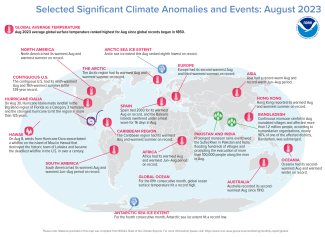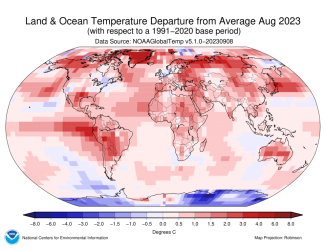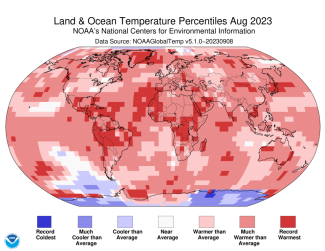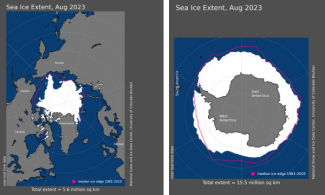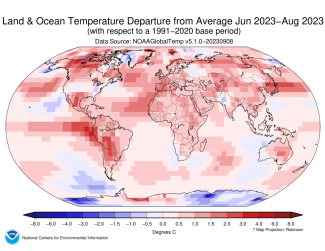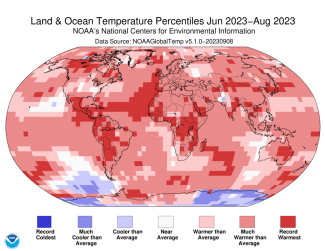Earth had its warmest August and June–August period on record; fifth consecutive month of record-high global ocean surface temperature

August and Seasonal Highlights:
- Asia, Africa, North America and South America each had their warmest August on record.
- Record-warm temperatures covered nearly 13% of the world's surface this August, which was the highest August percentage since the start of records in 1951.
- August 2023 set a record for the highest monthly sea surface temperature anomaly (+1.85°F or +1.03°C) of any month in NOAA’s 174-year record.
- Antarctica saw its fourth consecutive month with the lowest sea ice extent on record, and global sea ice extent set a record low for August.
- Eight of the 19 named storms that occurred across the globe in August reached major tropical cyclone strength (≥111 mph), which tied August 2015 for the most on record for the month.
Globally, August 2023 was the warmest August in the 174-year NOAA record. The year-to-date (January–August) global surface temperature ranked as the second warmest such period on record. According to NCEI’s Global Annual Temperature Outlook and data through August, there is a 95% probability that 2023 will rank among the two warmest years on record.
This monthly summary, developed by scientists at NOAA’s National Centers for Environmental Information, is part of the suite of climate services NOAA provides to government, business, academia and the public to support informed decision-making.
Monthly Global Temperature
The August global surface temperature was 2.25°F (1.25°C) above the 20th-century average of 60.1°F (15.6°C) and ranks as the warmest August in NOAA’s 174-year record. This was 0.52°F (0.29°C) above the previous record from August 2016 and marks the third-highest monthly temperature anomaly of any month on record.
“This analysis highlights the suite of climate services provided by NOAA, which informs a climate-ready nation,” said NOAA Chief Scientist Dr. Sarah Kapnick. “Not only was last month the warmest August on record by quite a lot, it was also the globe’s 45th-consecutive August and the 534th-consecutive month with temperatures above the 20th-century average. Global marine heat waves and a growing El Niño are driving additional warming this year, but as long as emissions continue driving a steady march of background warming, we expect further records to be broken in the years to come.”
Four continents—Asia, Africa, North America and South America—had their warmest August on record. Europe and Oceania each had their second-warmest August on record. It was the warmest August on record for the Arctic. For the fifth consecutive month, global sea surface temperature hit a record high for the month, and overall August 2023 set a record for the highest monthly sea surface temperature anomaly (+1.85°F or +1.03°C) of any month in NOAA’s 174-year record.
Temperatures were above average throughout most of South America, Africa, Asia, North America, the Arctic and Oceania. Parts of southern North America, central South America, western and central Africa, central, southern and eastern Asia and northwestern and eastern Oceania experienced record-warm temperatures this month. Sea surface temperatures were above average across much of the northern, western and southwestern Pacific as well as the Atlantic and the Indian Ocean. Record-warm temperatures covered nearly 13% of the world's surface this August, which was the highest August percentage since the start of records in 1951.
Temperatures were near to cooler than average across parts of western and northeastern Russia as well as Antarctica. Sea surface temperatures were near to below average over parts of the southeastern, central and eastern tropical Pacific. Less than 1% of the world's surface had a record-cold August.
Sea Ice and Snow Cover
August 2023 set a record for the lowest global August sea ice extent on record. Globally, sea ice extent in August 2023 was about 550,000 square miles less than the previous record low from August 2019. Sea ice extent in Antarctica continued to track at record lows; Antarctica saw its fourth consecutive month with the lowest sea ice extent on record.
The Arctic sea ice extent for August 2023 ranked as the eighth smallest in the satellite record at 2.15 million square miles, or about 330,000 square miles below the 1991–2020 average. The August 2023 Antarctic sea ice extent ranked lowest on record at 5.98 million square miles, or 900,000 square miles below the 1991–2020 average. Six of the first eight months in 2023 have seen Antarctic sea ice extent at record-breaking low levels.
Global Precipitation
The ongoing El Niño helped intensify the eastern Pacific Intertropical Convergence Zone (ITCZ) and provided dry conditions over most of the region between the Indian and Pacific Oceans. The South Asian monsoon was dry over India and wet over China. The west coast of the U.S. was wetter than normal with Hurricane Hilary drenching southern California, while the rest of the southwestern U.S. was dry, along with Mexico and Central America. The June–August season reflected El Niño in the tropical Pacific region, and had a very high global precipitation total. Above-average August precipitation was observed across the eastern United States, northern Europe and scattered areas in eastern Asia. Meanwhile, drier-than-average conditions were present across much of the southwestern United States, southwestern Europe, China, India, Pakistan, Mexico, Central America, central South America, Brazil and Australia.
Seasonal Global Temperature
The June–August 2023 global surface temperature was 2.07°F (1.15°C) above the 20th-century average of 60.1°F (15.6°C). This ranks as the warmest June–August period in the 174-year record, and 0.43°F (0.24°C) above the previous record. The past 10 June–August periods are the 10 warmest such periods on record.
The June–August period is defined as the Northern Hemisphere's meteorological summer and the Southern Hemisphere's meteorological winter. The Northern Hemisphere summer 2023 temperature was the warmest on record at 2.59°F (1.44°C) above average. The Southern Hemisphere winter temperature also ranked warmest on record at 1.53°F (0.85°C) above average.
North America had its warmest meteorological summer on record. Asia, Africa and South America also had their warmest June–August periods, and Oceania had its warmest winter on record. Europe had its third-warmest summer. It was the warmest summer on record for the Arctic.
Global Tropical Cyclones
Nineteen named storms occurred across the globe in August, which is tied for the third most for August since 1981. Eight of those reached major tropical cyclone strength (≥111 mph), which ties August 2015 for the most on record. The global accumulated cyclone energy (ACE) was the third highest on record for August and the fifth highest for the January–August period. The Atlantic, with six storms in August including two hurricanes, had activity that was considered above normal by all metrics. The East Pacific basin saw six storms in August including three major hurricanes, and its ACE for August was more than twice the 1991–2020 average. Six of the seven storms that formed in the West Pacific during August became typhoons, and the ACE for the West Pacific basin was about 45% above the 1991–2020 average.
For a more complete summary of climate conditions and events, see our August 2023 Global Climate Report or explore our Climate at a Glance Global Time Series.

